SEO
A Complete B2B SEO Strategy Guide for 2022
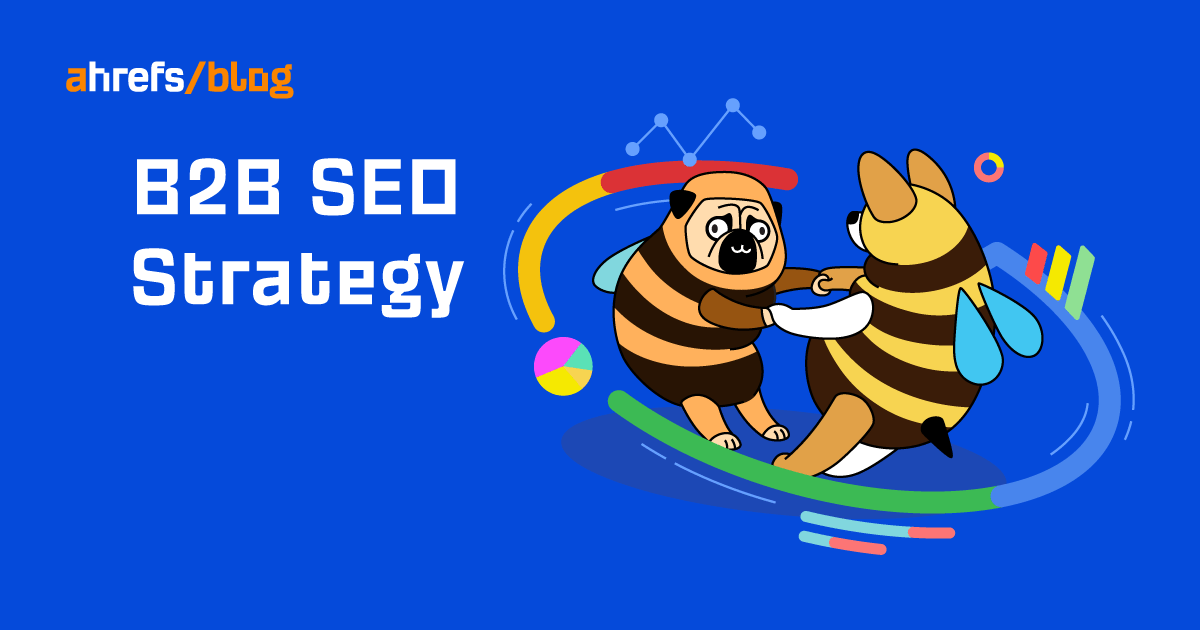
If you own a business that offers goods and services to other businesses (like we do here at Ahrefs), then you’re probably wondering how to get your products/services in front of your customers organically on Google.
Luckily, we’ve been doing this for years, so we’ve learned a thing or two about B2B SEO strategies. Today, you’re going to learn how to implement your own SEO strategy step by step!
In this guide, we’ll cover the following:
B2B SEO (business-to-business search engine optimization) is the process of creating and optimizing pages on your website to rank for keywords on search engines like Google.
As you can tell from the definition above, B2B SEO doesn’t really differ that much from B2C SEO (business-to-consumer search engine optimization). While the reader may be different—you’re talking to executives and managers—the process is pretty much the same.
Any SEO strategy is simple:
- Find keywords (related to what you’re selling) that your target customers are searching for on Google
- Create search-optimized pages that best answer those searches
- Build links to those pages
And that’s exactly what you’ll learn to do in this guide.
We currently get an estimated 1.3M monthly visits from organic search:

Data from Ahrefs’ Site Explorer.
Here’s the simple three-step B2B SEO strategy we used to achieve that:
- Find keywords your target customers are searching for
- Plan, create, and optimize content for those keywords
- Get backlinks to pages
Step 1. Find keywords your target customers are searching for
You can’t have an SEO strategy without knowing what your customers are searching for. Good keyword research is the difference between getting a positive ROI and wasting your time and money on rankings that don’t net your business any profit.
There are many ways to do keyword research. But the simplest starting point is to look at what your business competitors are ranking for. Here’s how:
- Find competitors invested in SEO
- See what they’re ranking for
First, think of “seed keywords” to get you started. These are keywords you think your customers may be searching for to find your products/services or solutions.
For example, if you sell software that helps business owners create beautiful designs easily (like Canva does), here are some keywords you can start with:
- Photo editor
- Logo maker
- Graph maker
- GIF maker
Think of the most basic words your customers may type in Google to find your offerings.
Once you’ve brainstormed a list of five to 10 seed keywords, plug those keywords into Ahrefs’ Keywords Explorer. Then click the “By domains” tab under Traffic share. This is how you find your search competitors.

It looks like Design Hill, Graphic Springs, and Tailor Brands are all potential search competitors for Canva.
Who comes up when you plug in your seed keywords? Put these search competitor URLs into a spreadsheet. Repeat for each seed keyword.
Next, use Ahrefs’ Content Gap tool to find keywords your competitors are ranking for that you can also target. Plug your website into Ahrefs, then click “Content gap” in the sidebar.

Plug your competitors into the tool, like so:

Hit “Show keywords,” and you’ll see a list of all the keywords that your competitors’ websites rank for, but your website does not.

If a keyword looks promising, open a new tab and search for it on Google to see the current search results. This will give you an idea of what kind of content is ranking for that keyword.
For example, if we search “discord logo” from the list above, it appears this won’t be a good keyword to target. It seems to be mostly just people looking to download Discord’s logo:

However, if we scroll down, we see a competitor ranking for the keyword with a guide to creating Discord logos:

This signifies two things:
- People may be searching for a logo maker when they search for “discord logo.”
- If we create a similar landing page, we can potentially rank for this keyword as well.
Based on this information, I’ll add this keyword to my list of potential keywords to target. Here’s how to create a list on Ahrefs: On the “keyword overview” page, click the “+ Add to” button, hover over “Keywords list,” then click “+ New list.”

I recommend creating three lists based on importance:
- High importance – Keywords that are likely to earn you a high profit. Target these first.
- Low importance – Keywords that are not likely to earn you a good profit or will take longer to earn you a profit. But you may still want to target these in the future.
- Link building – Keywords that receive a lot of natural links, such as statistical keywords or informational pages that other articles may link to as a resource.
The keyword “discord logo,” for example, is a low-importance keyword, as we aren’t sure how many people searching for it are actually searching for a tool to make their own logo versus how many just want to download Discord’s actual logo.
Another way of determining the profit potential of a given keyword is the CPC column. A high CPC can signify there is a lot of money being made from a given keyword. “Discord logo” only has a CPC of $0.70, so it’s probably not very profitable.
Sidenote.
While a high CPC can signal potentially high-profit keywords, it shouldn’t be the only determining factor. For example, the keyword “seo services” has a $25 CPC. But we won’t target it for Ahrefs’ website because Ahrefs doesn’t offer SEO services.
Before we move on to the next step, let’s look at an example of a high-importance keyword and a link building keyword.
The keyword “fitness logo” is potentially a high-importance keyword. It has a good search volume (4,700) and a fairly high CPC ($3.00).

If we look at the SERP, we’ll see tools that let you design your own fitness business logo. If Canva builds and optimizes a landing page targeting “fitness logo,” it will likely rank for this keyword and make a decent amount of extra income.

Finally, an example of a link building keyword is “font pairings.” Canva created a guide to font pairing that has links from more than 2,300 referring domains:
Of course, it may have done some outreach to build these links (which we’ll cover later). But the majority of links are naturally from other bloggers and websites linking to Canva’s guide, which serves as a resource for their readers. I know this because if we look at the guide’s backlinks, we see lots of natural ones.

Note that link building keywords are a long-term strategy and should be of a lower priority for newer sites. This is because you typically need decent domain authority to rank for these keywords.
Next, go through all the keywords from Ahrefs’ Content Gap tool and try to find at least five to 10 keywords for each of your three lists.
Still need help finding keywords?
If you feel the keywords you’ve found aren’t good enough or you need more help, check out this in-depth guide to keyword research. It goes into more detail about finding the right keywords.
Step 2. Plan, create, and optimize your content
Now that you know what keywords to target, let’s make a spreadsheet to help you plan and execute your SEO strategy. You can use this spreadsheet template as you follow along.
To begin, export your three keyword lists. Then copy the Keyword, Search Volume, KD, and CPC columns, and paste them into your spreadsheet. It should look like this:

Let’s begin understanding and filling in the other columns. First, the Priority column shows which category (high, low, or link building) each keyword falls under.
The next three columns are the three Cs of search intent:
- Content type
- Content format
- Content angle
Search intent is the why behind a search query. In other words, why did this person do this search? Did they want to learn something? Were they looking to make a purchase? Or were they looking for a particular website?
If you don’t know the search intent of a keyword, you may end up optimizing a page for that keyword and not ranking for it.
I’ll go over the basics of how to determine search intent. But for a deeper understanding, read our full guide to search intent.
1. Content type
The content type can be any of the following:
- Blog post
- Product page
- Category page
- Landing page
In the case of “fitness logo,” the search results are all landing pages. Here’s what I see when I search for “fitness logo” and click on the first result:

This page displays premade fitness logos you can edit and download. If you scroll down, you’ll see a write-up about fitness logos and the company’s services and software.
Now let’s go back and look at some of the other results. Here’s the result in position #2:

This company has a slightly different approach. Its page shows a form and some text above the fold (the area you see on the screen before you scroll down). But if we scroll down, we see samples of logos and some text about its services.
The third result on the search page is mostly similar to the first two:

The goal of this SERP research is to see what kind of content Google wants for a given keyword so that we can create something similar.
This doesn’t mean we should copy the content entirely. But if Google ranks pages that show examples of logos and logo designs that users can edit, we should take some inspiration from them. This is as if we create a page that is just text without logo examples, we may not rank for this keyword because it’s not what searchers want to see.
2. Content format
The content format only applies to blog posts, so “fitness logo” won’t need to be categorized. But to give you some ideas, these six formatting styles are the most common for a blog post:
- How-to guide
- Step-by-step tutorial
- List post
- Opinion piece
- Review
- Comparison
So, for example, the keyword “font pairing” that we discussed in Step 1 will be a list post because it lists 30 font pairings that go well together.
3. Content angle
The content angle is the unique selling point of the top-ranking posts and pages. It can provide insight into what searchers want to see when they search for a given keyword.
For example, when you search “fitness logo,” you can see two common angles:

- Fitness logo maker
- Fitness logo ideas
Here’s what the above tells me: To rank, I either need a page that provides a fitness logo maker tool or a list post about fitness logo ideas. The angle isn’t a hard-and-fast rule. But it gives you some insight into specific wording you may want to include in your title tags and meta descriptions.
Read the full guide to search intent to learn more about how to use content angles.
Fill out your spreadsheet
Now that you understand what all the columns in the spreadsheet mean, finish your SERP research. Then fill in the missing data for each keyword.
It should look something like this:

Outline, draft, and publish your pages
Once you know all the keywords you’re going to target, the next step is actually creating the pages on your site. Rather than walking you through that entire process in this article, I’ll refer you to our guide to creating SEO content.
It covers our entire writing process:
- Find a proven topic
- Analyze search intent
- Write an outline
- Write a draft
- Edit your draft
- Make your content visually appealing
- Write a compelling title and description
- Upload your post
Step 3. Outreach and link building
After you’ve published your pages, the third and final step of our B2B SEO strategy is to build backlinks. A backlink is a link from another website pointing to a page on your website.
Reaching out for these links is called link building, and backlinks are arguably the most important Google ranking factor. In our study of over 1 billion pages, we found that the biggest reason a page doesn’t rank is due to a lack of backlinks.
There are many ways to build links. Here are a few to get you started:
Rather than explain each of these here, just click on the links above to learn more. If you want to dive deeper into link building and what makes a good backlink, read our full guide to link building.
Final thoughts
At this point, you’ve seen the entire strategy from beginning to end. However, you haven’t seen a B2B SEO strategy in action yet.
I recommend checking out the websites and blogs of the B2B businesses below that have used SEO successfully. Hopefully, these can give you inspiration and guidance. I also recommend plugging them into Ahrefs’ Site Explorer for a deeper understanding of their strategies:
Source link
SEO
Measuring Content Impact Across The Customer Journey
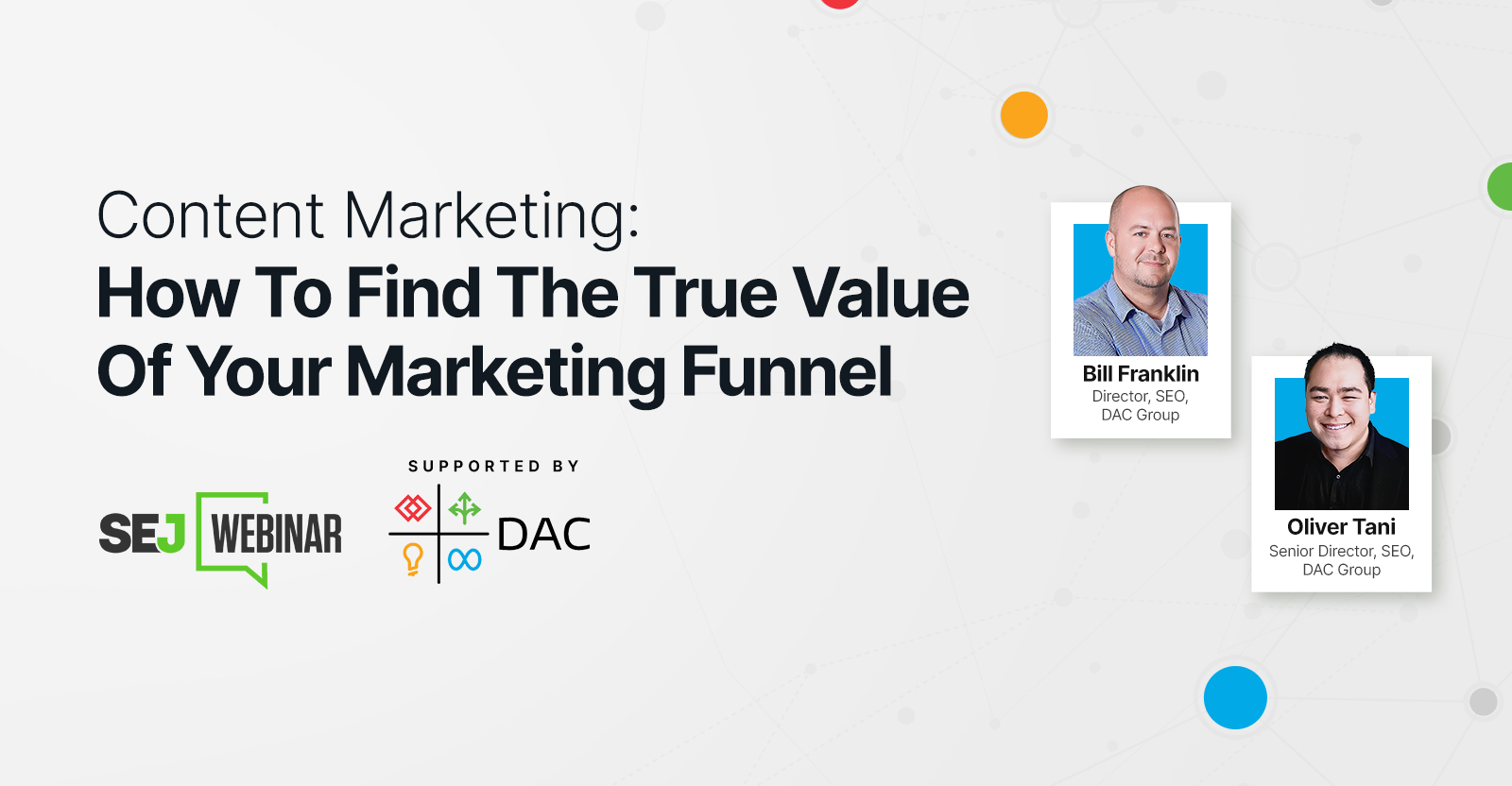
Understanding the impact of your content at every touchpoint of the customer journey is essential – but that’s easier said than done. From attracting potential leads to nurturing them into loyal customers, there are many touchpoints to look into.
So how do you identify and take advantage of these opportunities for growth?
Watch this on-demand webinar and learn a comprehensive approach for measuring the value of your content initiatives, so you can optimize resource allocation for maximum impact.
You’ll learn:
- Fresh methods for measuring your content’s impact.
- Fascinating insights using first-touch attribution, and how it differs from the usual last-touch perspective.
- Ways to persuade decision-makers to invest in more content by showcasing its value convincingly.
With Bill Franklin and Oliver Tani of DAC Group, we unravel the nuances of attribution modeling, emphasizing the significance of layering first-touch and last-touch attribution within your measurement strategy.
Check out these insights to help you craft compelling content tailored to each stage, using an approach rooted in first-hand experience to ensure your content resonates.
Whether you’re a seasoned marketer or new to content measurement, this webinar promises valuable insights and actionable tactics to elevate your SEO game and optimize your content initiatives for success.
View the slides below or check out the full webinar for all the details.
SEO
How to Find and Use Competitor Keywords
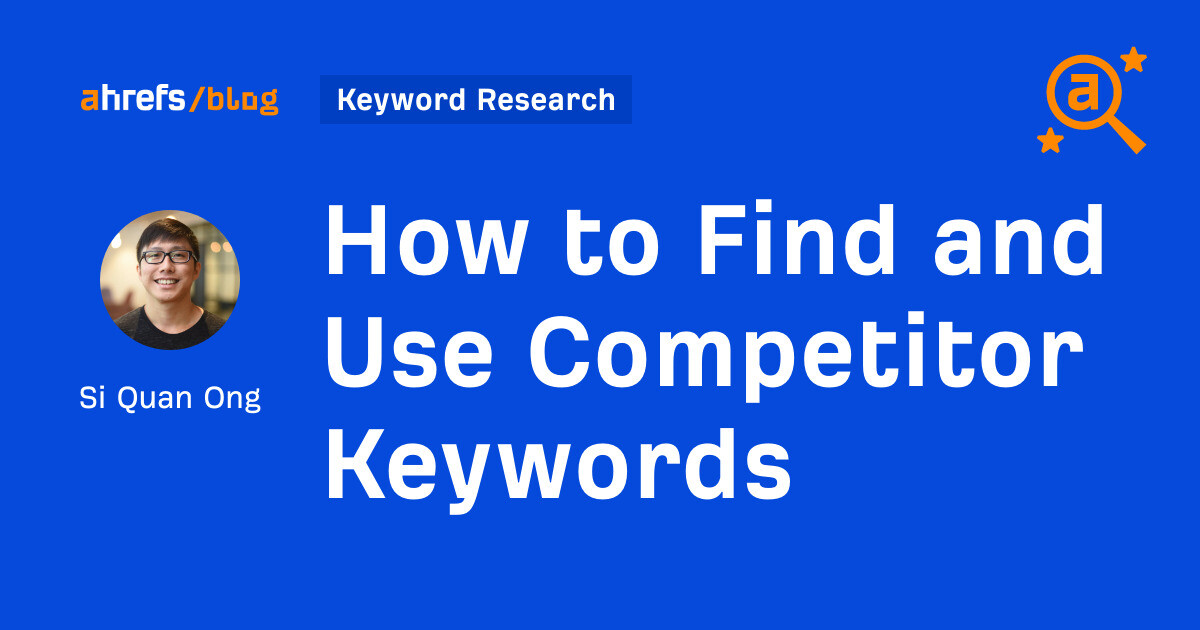
Competitor keywords are the keywords your rivals rank for in Google’s search results. They may rank organically or pay for Google Ads to rank in the paid results.
Knowing your competitors’ keywords is the easiest form of keyword research. If your competitors rank for or target particular keywords, it might be worth it for you to target them, too.
There is no way to see your competitors’ keywords without a tool like Ahrefs, which has a database of keywords and the sites that rank for them. As far as we know, Ahrefs has the biggest database of these keywords.
How to find all the keywords your competitor ranks for
- Go to Ahrefs’ Site Explorer
- Enter your competitor’s domain
- Go to the Organic keywords report
The report is sorted by traffic to show you the keywords sending your competitor the most visits. For example, Mailchimp gets most of its organic traffic from the keyword “mailchimp.”


Since you’re unlikely to rank for your competitor’s brand, you might want to exclude branded keywords from the report. You can do this by adding a Keyword > Doesn’t contain filter. In this example, we’ll filter out keywords containing “mailchimp” or any potential misspellings:
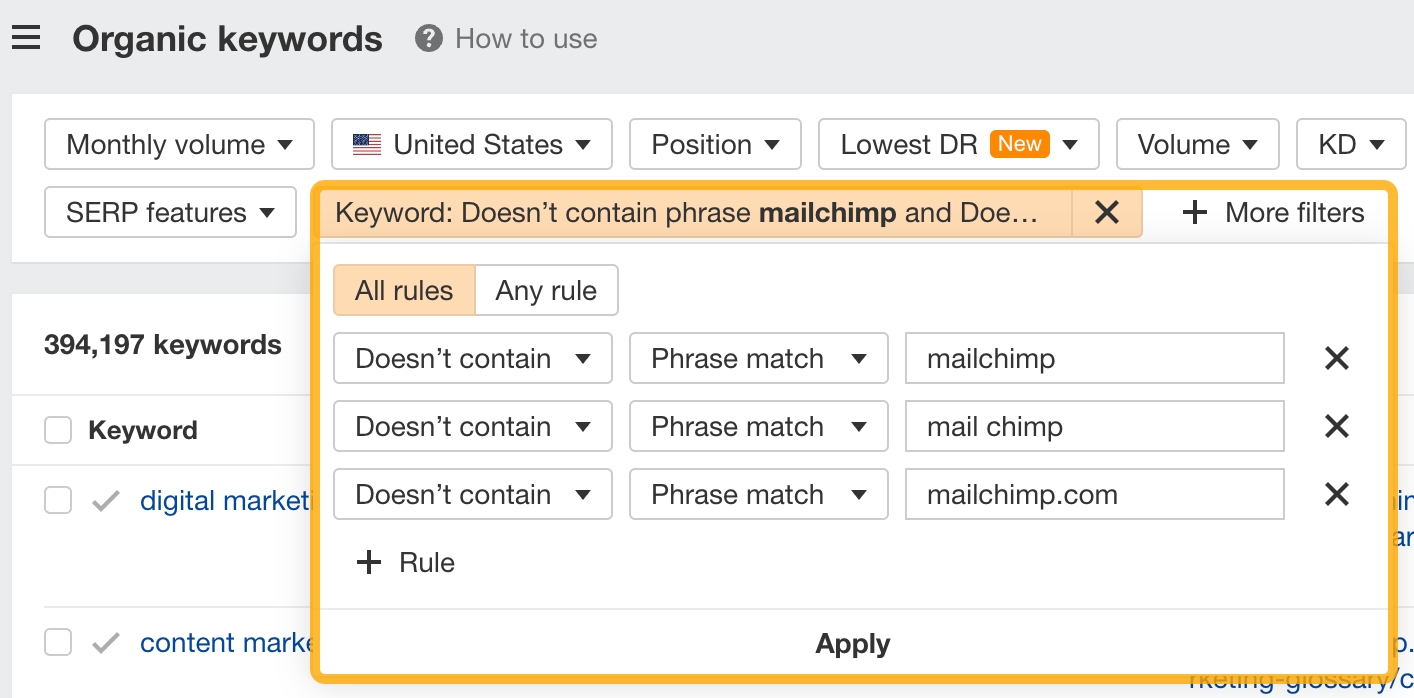

If you’re a new brand competing with one that’s established, you might also want to look for popular low-difficulty keywords. You can do this by setting the Volume filter to a minimum of 500 and the KD filter to a maximum of 10.
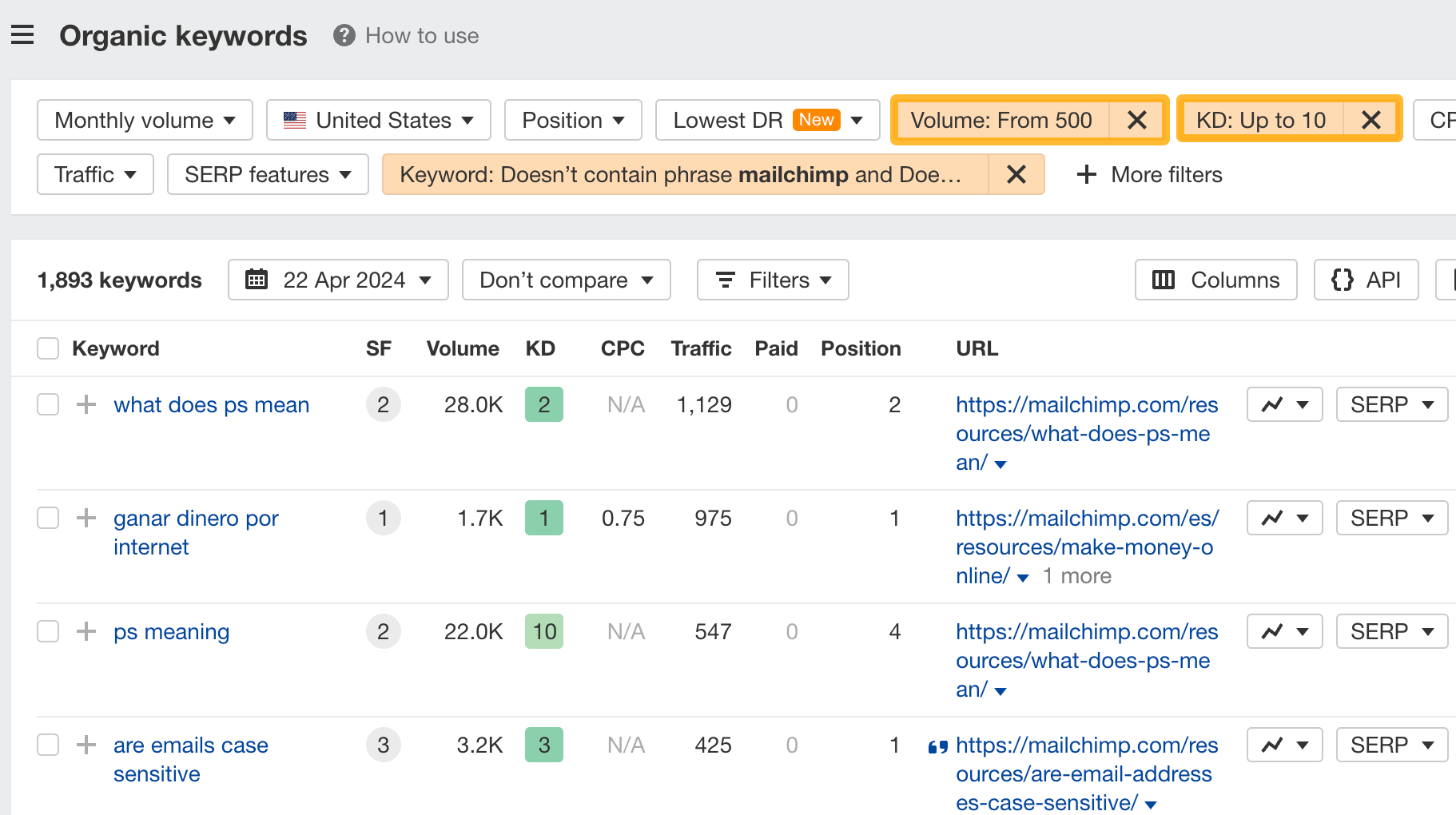

How to find keywords your competitor ranks for, but you don’t
- Go to Competitive Analysis
- Enter your domain in the This target doesn’t rank for section
- Enter your competitor’s domain in the But these competitors do section
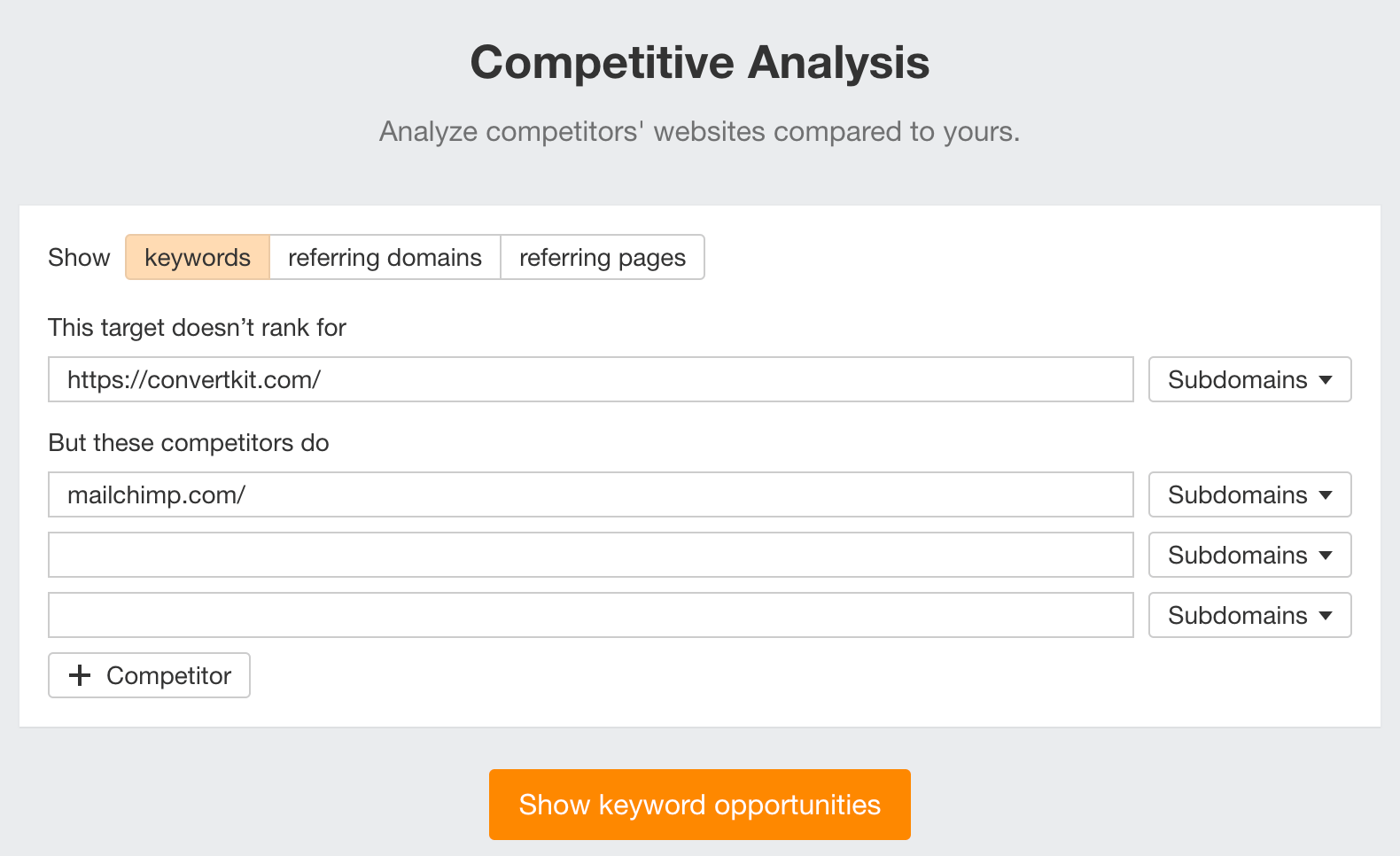

Hit “Show keyword opportunities,” and you’ll see all the keywords your competitor ranks for, but you don’t.
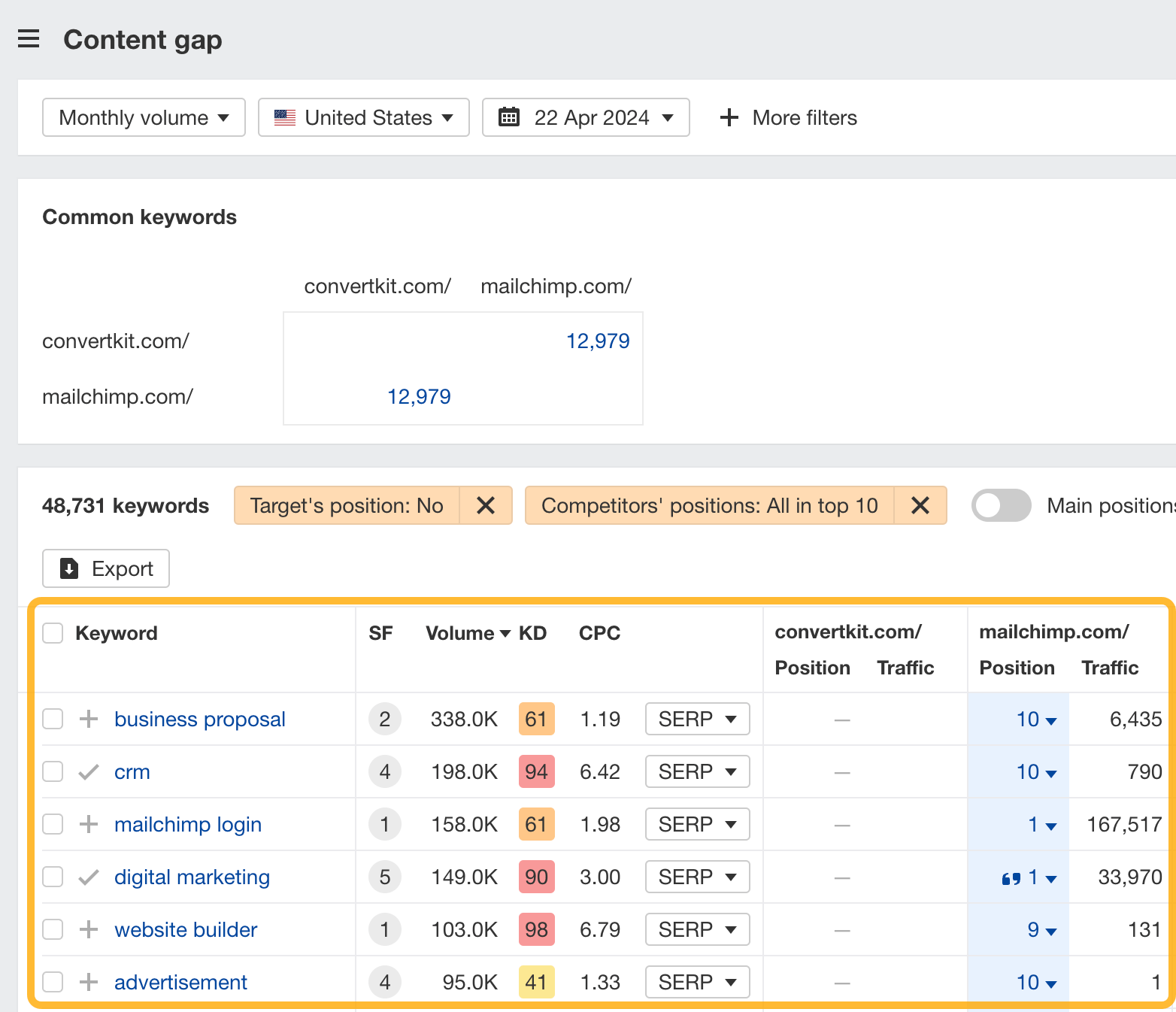

You can also add a Volume and KD filter to find popular, low-difficulty keywords in this report.
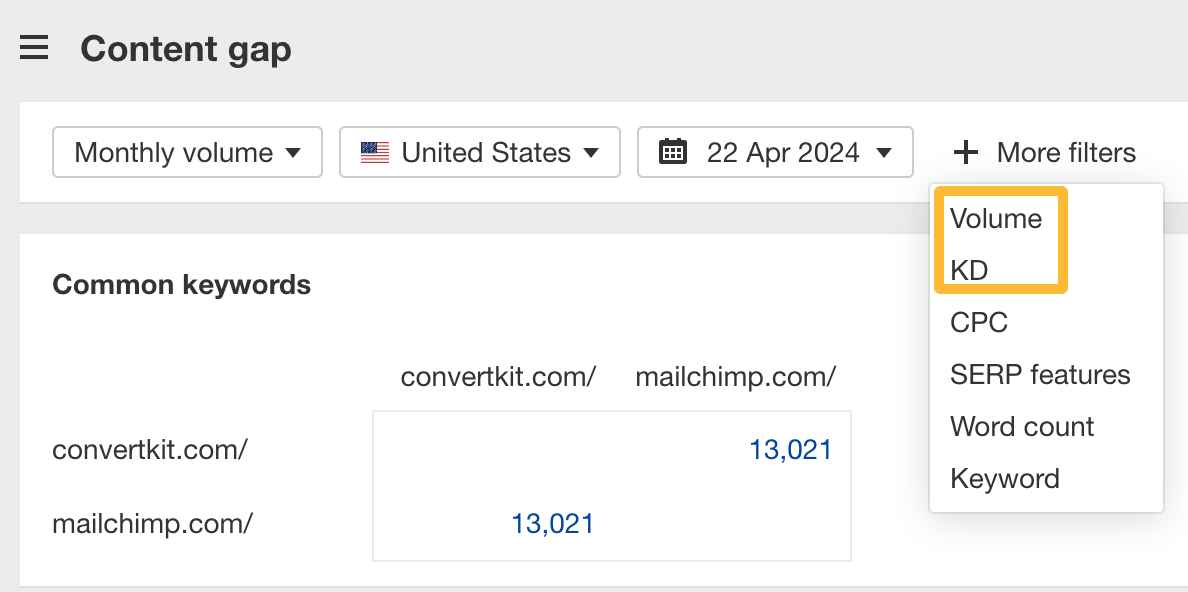

How to find keywords multiple competitors rank for, but you don’t
- Go to Competitive Analysis
- Enter your domain in the This target doesn’t rank for section
- Enter the domains of multiple competitors in the But these competitors do section
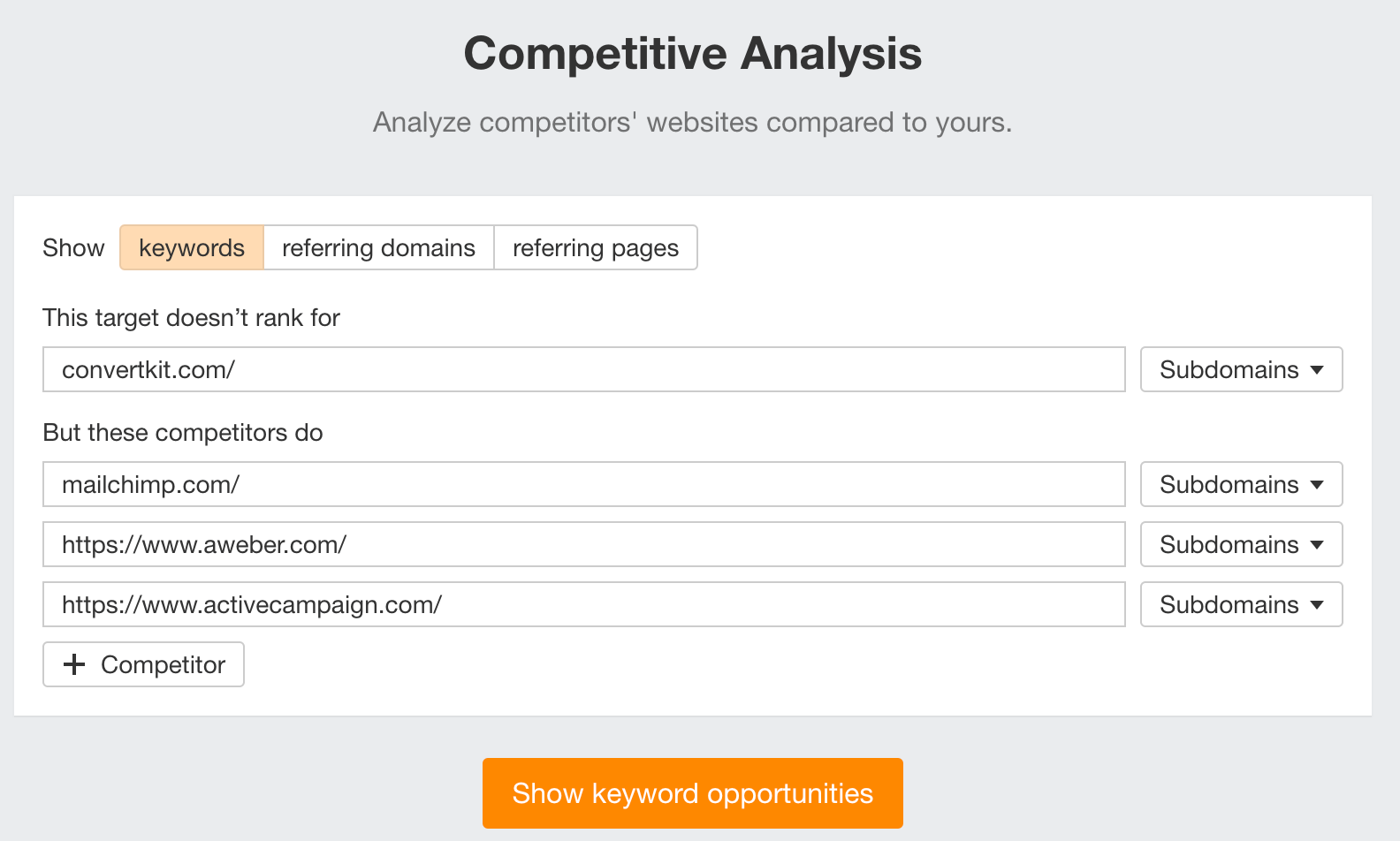

You’ll see all the keywords that at least one of these competitors ranks for, but you don’t.
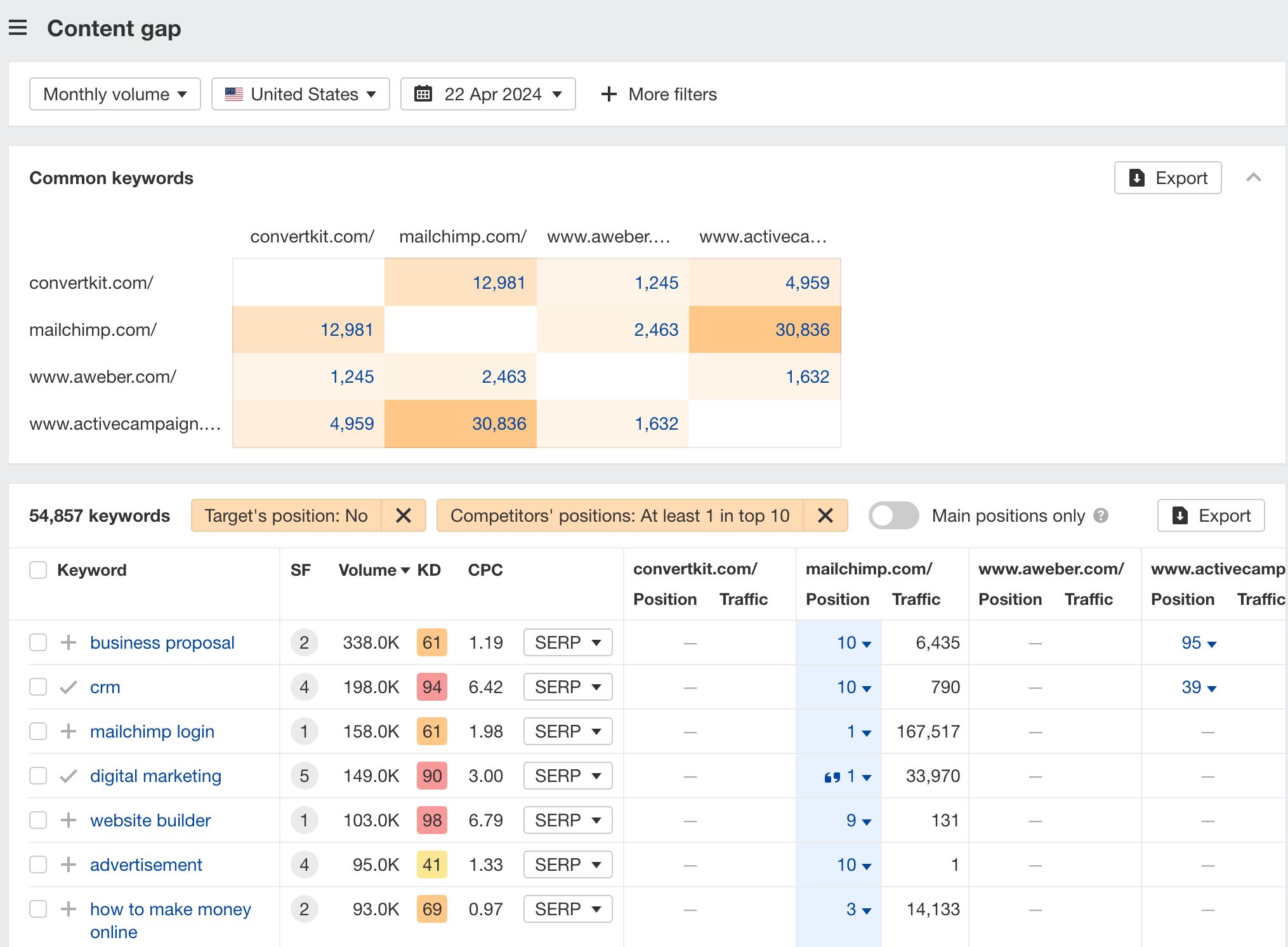

You can also narrow the list down to keywords that all competitors rank for. Click on the Competitors’ positions filter and choose All 3 competitors:
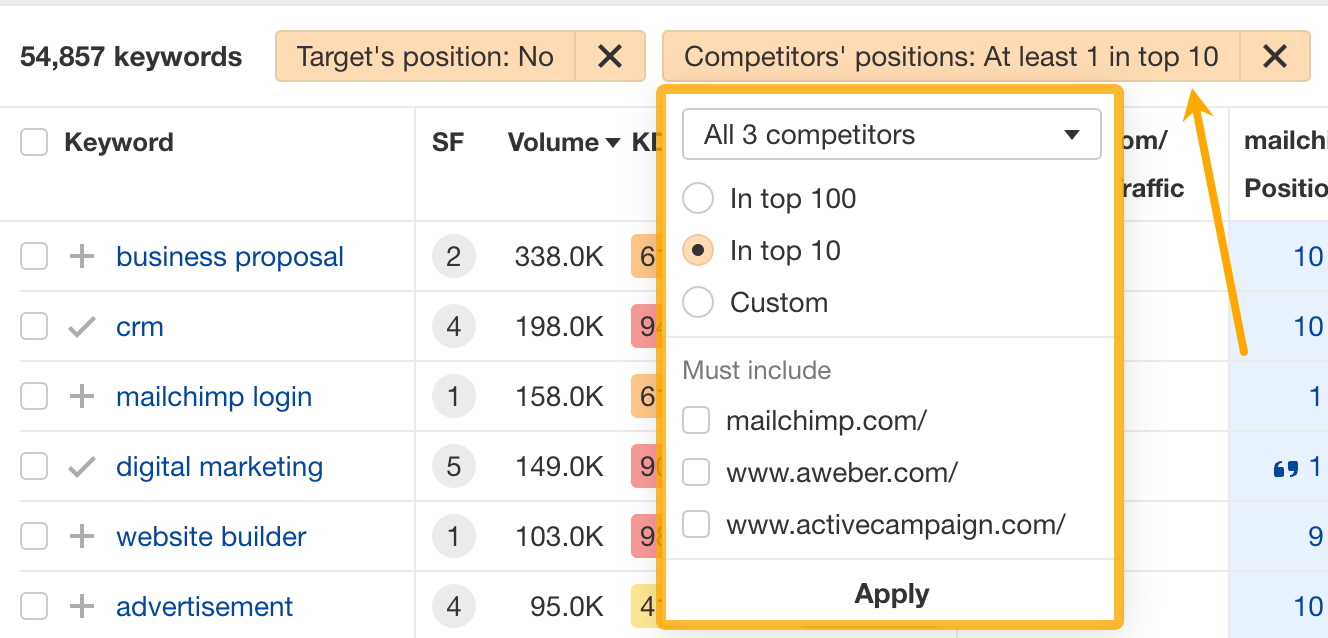

- Go to Ahrefs’ Site Explorer
- Enter your competitor’s domain
- Go to the Paid keywords report
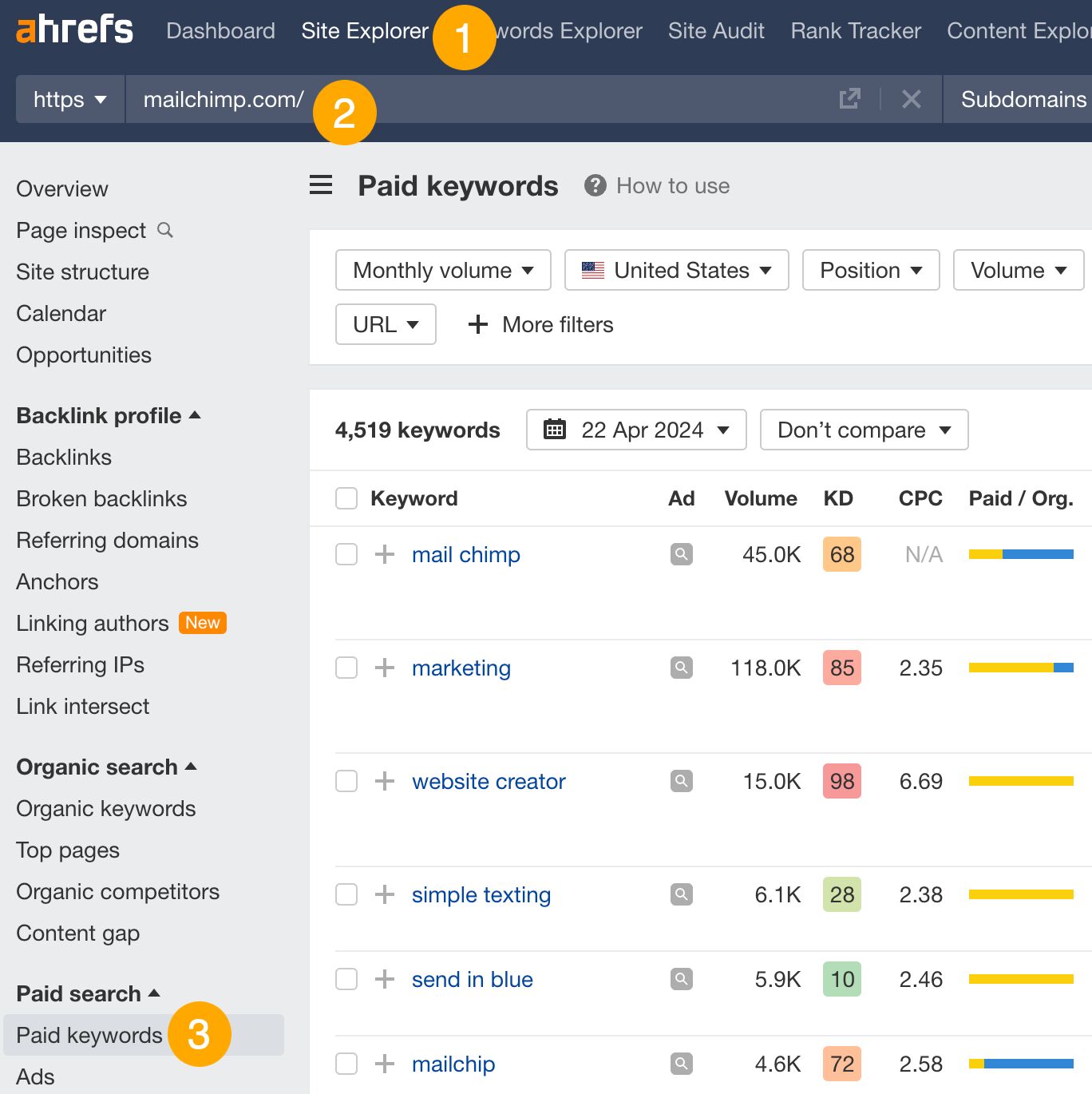

This report shows you the keywords your competitors are targeting via Google Ads.
Since your competitor is paying for traffic from these keywords, it may indicate that they’re profitable for them—and could be for you, too.
You know what keywords your competitors are ranking for or bidding on. But what do you do with them? There are basically three options.
1. Create pages to target these keywords
You can only rank for keywords if you have content about them. So, the most straightforward thing you can do for competitors’ keywords you want to rank for is to create pages to target them.
However, before you do this, it’s worth clustering your competitor’s keywords by Parent Topic. This will group keywords that mean the same or similar things so you can target them all with one page.
Here’s how to do that:
- Export your competitor’s keywords, either from the Organic Keywords or Content Gap report
- Paste them into Keywords Explorer
- Click the “Clusters by Parent Topic” tab
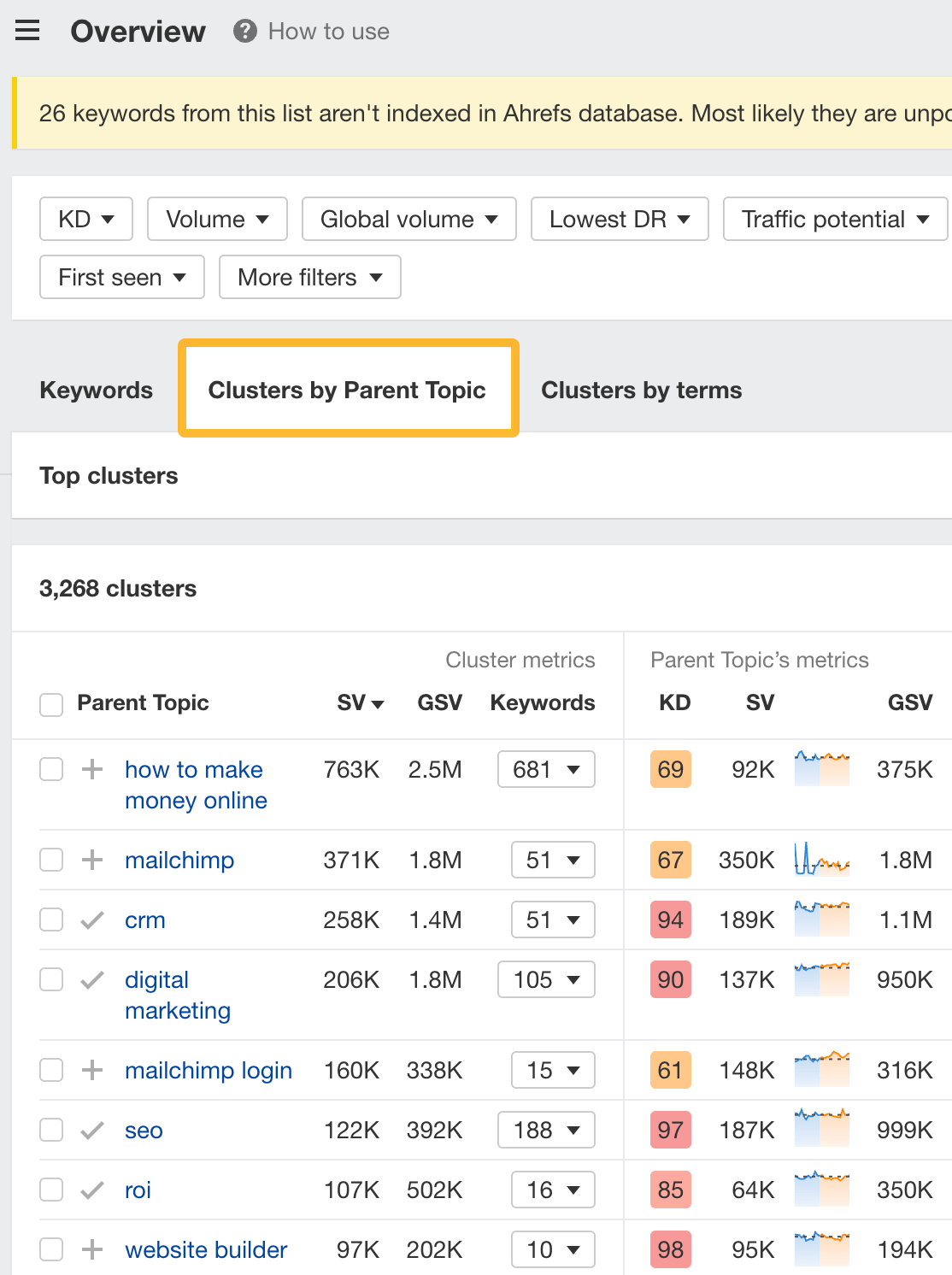

For example, MailChimp ranks for keywords like “what is digital marketing” and “digital marketing definition.” These and many others get clustered under the Parent Topic of “digital marketing” because people searching for them are all looking for the same thing: a definition of digital marketing. You only need to create one page to potentially rank for all these keywords.
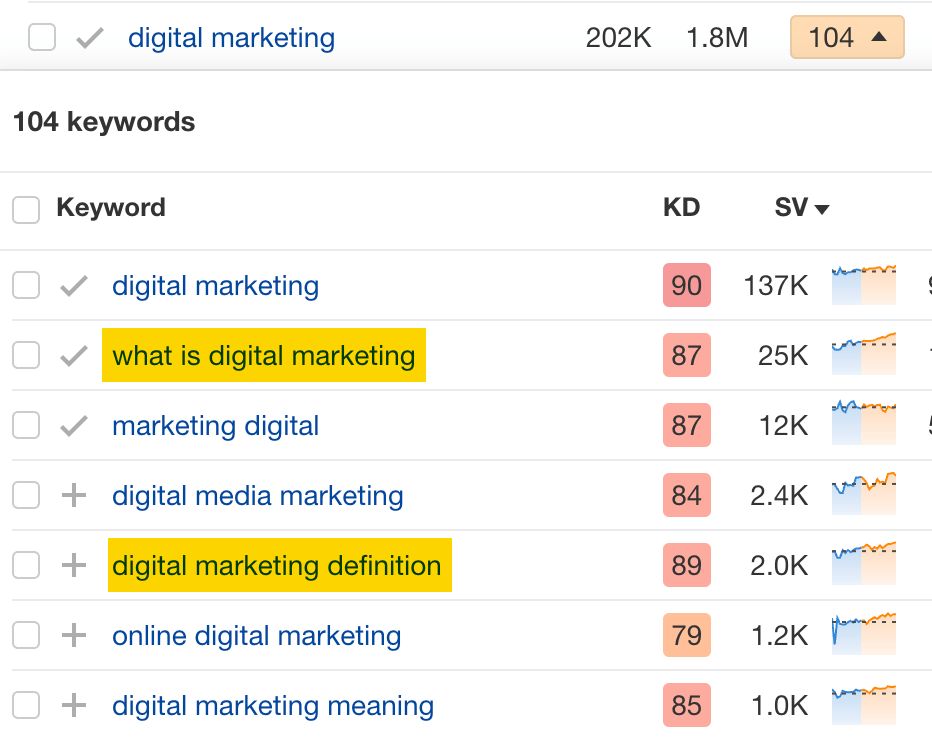

2. Optimize existing content by filling subtopics
You don’t always need to create new content to rank for competitors’ keywords. Sometimes, you can optimize the content you already have to rank for them.
How do you know which keywords you can do this for? Try this:
- Export your competitor’s keywords
- Paste them into Keywords Explorer
- Click the “Clusters by Parent Topic” tab
- Look for Parent Topics you already have content about
For example, if we analyze our competitor, we can see that seven keywords they rank for fall under the Parent Topic of “press release template.”


If we search our site, we see that we already have a page about this topic.


If we click the caret and check the keywords in the cluster, we see keywords like “press release example” and “press release format.”
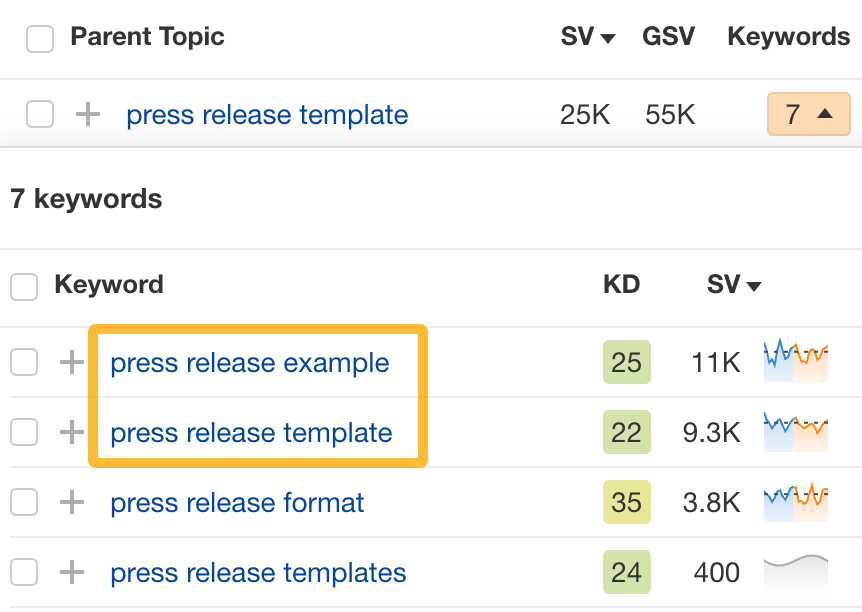

To rank for the keywords in the cluster, we can probably optimize the page we already have by adding sections about the subtopics of “press release examples” and “press release format.”
3. Target these keywords with Google Ads
Paid keywords are the simplest—look through the report and see if there are any relevant keywords you might want to target, too.
For example, Mailchimp is bidding for the keyword “how to create a newsletter.”


If you’re ConvertKit, you may also want to target this keyword since it’s relevant.
If you decide to target the same keyword via Google Ads, you can hover over the magnifying glass to see the ads your competitor is using.
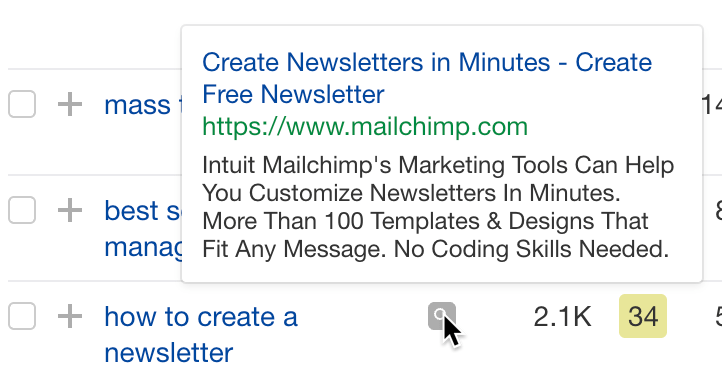

You can also see the landing page your competitor directs ad traffic to under the URL column.


Learn more
Check out more tutorials on how to do competitor keyword analysis:
SEO
Google Confirms Links Are Not That Important

Google’s Gary Illyes confirmed at a recent search marketing conference that Google needs very few links, adding to the growing body of evidence that publishers need to focus on other factors. Gary tweeted confirmation that he indeed say those words.
Background Of Links For Ranking
Links were discovered in the late 1990’s to be a good signal for search engines to use for validating how authoritative a website is and then Google discovered soon after that anchor text could be used to provide semantic signals about what a webpage was about.
One of the most important research papers was Authoritative Sources in a Hyperlinked Environment by Jon M. Kleinberg, published around 1998 (link to research paper at the end of the article). The main discovery of this research paper is that there is too many web pages and there was no objective way to filter search results for quality in order to rank web pages for a subjective idea of relevance.
The author of the research paper discovered that links could be used as an objective filter for authoritativeness.
Kleinberg wrote:
“To provide effective search methods under these conditions, one needs a way to filter, from among a huge collection of relevant pages, a small set of the most “authoritative” or ‘definitive’ ones.”
This is the most influential research paper on links because it kick-started more research on ways to use links beyond as an authority metric but as a subjective metric for relevance.
Objective is something factual. Subjective is something that’s closer to an opinion. The founders of Google discovered how to use the subjective opinions of the Internet as a relevance metric for what to rank in the search results.
What Larry Page and Sergey Brin discovered and shared in their research paper (The Anatomy of a Large-Scale Hypertextual Web Search Engine – link at end of this article) was that it was possible to harness the power of anchor text to determine the subjective opinion of relevance from actual humans. It was essentially crowdsourcing the opinions of millions of website expressed through the link structure between each webpage.
What Did Gary Illyes Say About Links In 2024?
At a recent search conference in Bulgaria, Google’s Gary Illyes made a comment about how Google doesn’t really need that many links and how Google has made links less important.
Patrick Stox tweeted about what he heard at the search conference:
” ‘We need very few links to rank pages… Over the years we’ve made links less important.’ @methode #serpconf2024″
Google’s Gary Illyes tweeted a confirmation of that statement:
“I shouldn’t have said that… I definitely shouldn’t have said that”
Why Links Matter Less
The initial state of anchor text when Google first used links for ranking purposes was absolutely non-spammy, which is why it was so useful. Hyperlinks were primarily used as a way to send traffic from one website to another website.
But by 2004 or 2005 Google was using statistical analysis to detect manipulated links, then around 2004 “powered-by” links in website footers stopped passing anchor text value, and by 2006 links close to the words “advertising” stopped passing link value, links from directories stopped passing ranking value and by 2012 Google deployed a massive link algorithm called Penguin that destroyed the rankings of likely millions of websites, many of which were using guest posting.
The link signal eventually became so bad that Google decided in 2019 to selectively use nofollow links for ranking purposes. Google’s Gary Illyes confirmed that the change to nofollow was made because of the link signal.
Google Explicitly Confirms That Links Matter Less
In 2023 Google’s Gary Illyes shared at a PubCon Austin that links were not even in the top 3 of ranking factors. Then in March 2024, coinciding with the March 2024 Core Algorithm Update, Google updated their spam policies documentation to downplay the importance of links for ranking purposes.
The documentation previously said:
“Google uses links as an important factor in determining the relevancy of web pages.”
The update to the documentation that mentioned links was updated to remove the word important.
Links are not just listed as just another factor:
“Google uses links as a factor in determining the relevancy of web pages.”
At the beginning of April Google’s John Mueller advised that there are more useful SEO activities to engage on than links.
Mueller explained:
“There are more important things for websites nowadays, and over-focusing on links will often result in you wasting your time doing things that don’t make your website better overall”
Finally, Gary Illyes explicitly said that Google needs very few links to rank webpages and confirmed it.
I shouldn’t have said that… I definitely shouldn’t have said that
— Gary 鯨理/경리 Illyes (so official, trust me) (@methode) April 19, 2024
Why Google Doesn’t Need Links
The reason why Google doesn’t need many links is likely because of the extent of AI and natural language undertanding that Google uses in their algorithms. Google must be highly confident in its algorithm to be able to explicitly say that they don’t need it.
Way back when Google implemented the nofollow into the algorithm there were many link builders who sold comment spam links who continued to lie that comment spam still worked. As someone who started link building at the very beginning of modern SEO (I was the moderator of the link building forum at the #1 SEO forum of that time), I can say with confidence that links have stopped playing much of a role in rankings beginning several years ago, which is why I stopped about five or six years ago.
Read the research papers
Authoritative Sources in a Hyperlinked Environment – Jon M. Kleinberg (PDF)
The Anatomy of a Large-Scale Hypertextual Web Search Engine
Featured Image by Shutterstock/RYO Alexandre
-

 PPC5 days ago
PPC5 days ago19 Best SEO Tools in 2024 (For Every Use Case)
-
SEARCHENGINES7 days ago
Daily Search Forum Recap: April 16, 2024
-

 SEO7 days ago
SEO7 days agoGoogle Clarifies Vacation Rental Structured Data
-

 MARKETING6 days ago
MARKETING6 days agoStreamlining Processes for Increased Efficiency and Results
-
SEARCHENGINES6 days ago
Daily Search Forum Recap: April 17, 2024
-
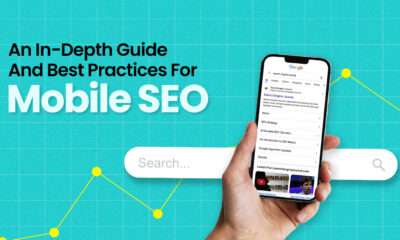
 SEO6 days ago
SEO6 days agoAn In-Depth Guide And Best Practices For Mobile SEO
-

 PPC6 days ago
PPC6 days ago97 Marvelous May Content Ideas for Blog Posts, Videos, & More
-

 MARKETING5 days ago
MARKETING5 days agoEcommerce evolution: Blurring the lines between B2B and B2C


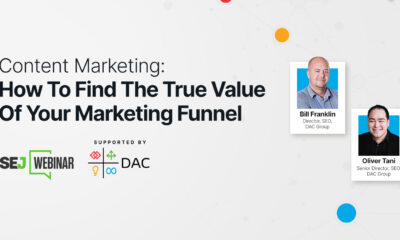



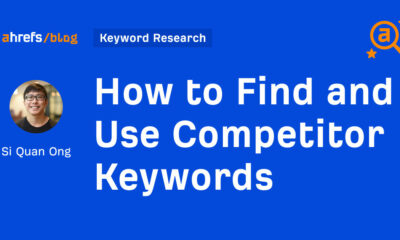



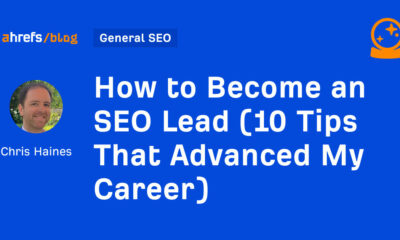



You must be logged in to post a comment Login